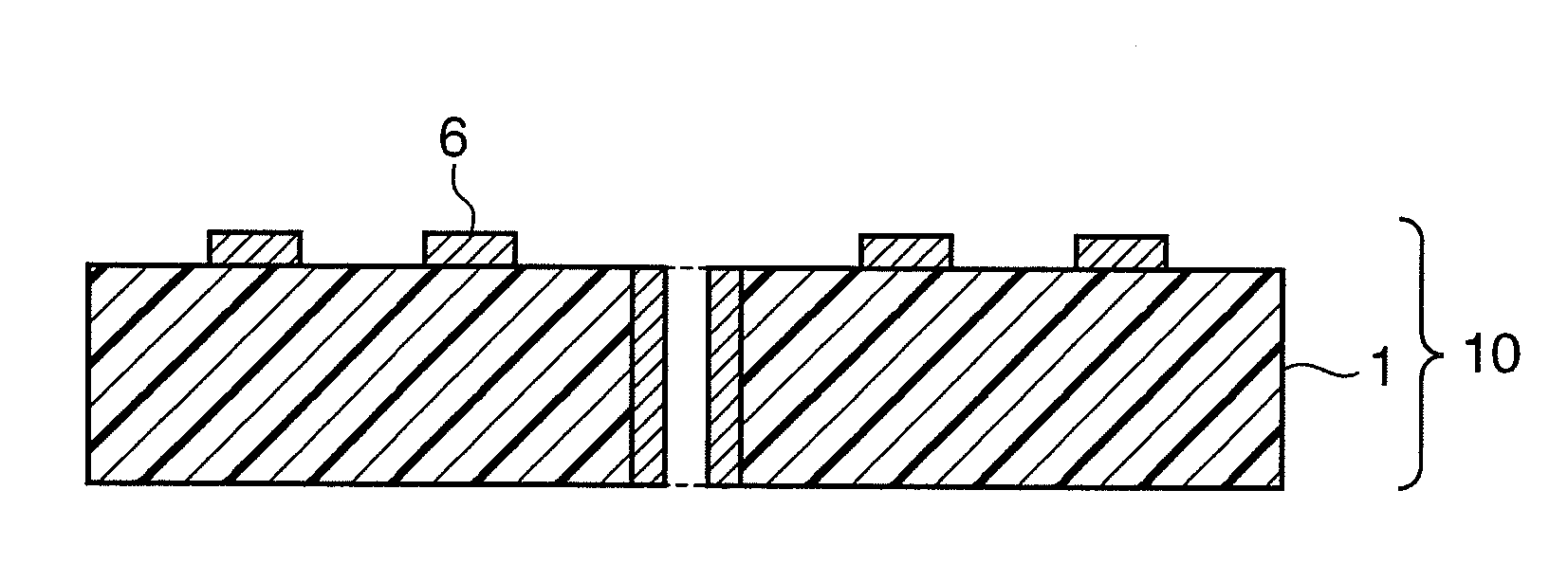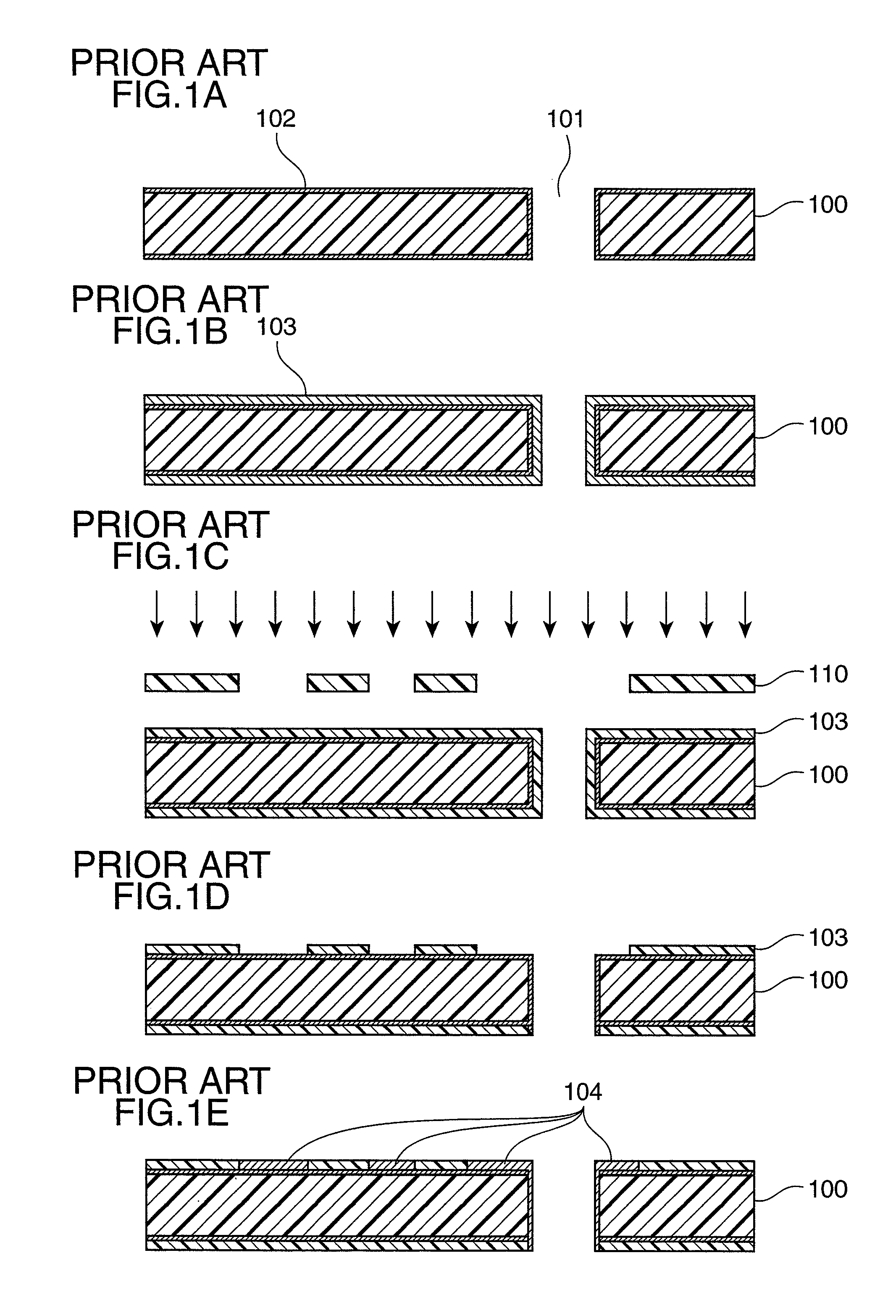Method of producing circuit board by additive method, and circuit board and multilayer circuit board obtained by the method
a technology of additive method and circuit board, which is applied in the direction of inspection/indentification of circuits, conductive pattern formation, and catalyst application resists, etc., can solve the problems of short circuiting and migration between wires, deterioration of mechanical strength of wiring, and circuits more vulnerable to circuit breakage, so as to achieve high-precision preservation of circuit profiles
- Summary
- Abstract
- Description
- Claims
- Application Information
AI Technical Summary
Benefits of technology
Problems solved by technology
Method used
Image
Examples
first embodiment (
Method of Producing a Circuit Board by Using Swellable Resin Film)
[0050]The method of producing a circuit board in the present embodiment will be described with reference to diagrams. FIGS. 5A to 5E are schematic cross-sectional views explaining the steps in the method of producing a circuit board in the first embodiment. In FIGS. 5A to 5E, 1 represents an insulative substrate; 2 represents a swellable resin film; 3 represents a circuit groove; 4 represents a through-hole penetrating through part of the circuit groove 3; 5 represents a plating catalyst; and 6 represents an electrolessly plated film.
[0051]In the production method of the present embodiment, as shown in FIG. 5A, a swellable resin film 2 is first formed on the surface of an insulative substrate 1. The swellable resin film means a resin film easily separated from the substrate surface by swelling with a particular liquid.
[0052]Various organic substrates used in production of circuit boards can be used as the insulative s...
example 1
[0090]A styrene-butadiene copolymer (SBR) film of 2 μm in thickness was formed on the surface of an epoxy resin substrate having a thickness of 100 μm (R1766, manufactured by Panasonic Electric Works Co., Ltd.). The film was formed by coating a styrene-butadiene copolymer (SBR) suspension in methylethylketone (MEK) (manufactured by Zeon Corporation, acid equivalents: 600, particle diameter: 200 nm, solid matter: 15%) on the main face of the epoxy resin substrate and drying the resulting coating film at 80° C. for 30 minutes.
[0091]Grooves having an almost rectangular cross section having a width of 20 μm and a depth of 30 μm and a particular pattern were formed on the epoxy resin substrate carrying the formed film by laser processing. MODEL 5330 manufactured by ESI equipped with a UV-YAG laser was used in the laser processing.
[0092]The laser-processed epoxy resin substrate was then immersed in a cleaner conditioner (surfactant solution of pH<1, C / N3320, manufactured by Rohm and Haas ...
second embodiment (
Method of Forming a Partial Reinforcing Structure in Fine Wiring)
[0100]It is possible to form a partial reinforcing structure for partial reinforcement of the circuit as will be described below by applying the method of producing a circuit board described in the first embodiment.
[0101]The method of producing a circuit board in the present embodiment will be described specifically with reference to drawings. Items common to those in the description of the first embodiment are described only briefly for prevention of duplication.
[0102]FIGS. 7A to 7E are schematic cross-sectional views respectively explaining the steps in the method of producing a circuit board in the second embodiment.
[0103]In the production method of the present embodiment, first as shown in FIG. 7A, a resin film 12 is formed on the surface of an insulative substrate 1.
[0104]Various organic substrates similar to those described in the first embodiment may be used as the insulative substrate 1. The resin film 12 is fo...
PUM
| Property | Measurement | Unit |
|---|---|---|
| Fraction | aaaaa | aaaaa |
| Fraction | aaaaa | aaaaa |
| Thickness | aaaaa | aaaaa |
Abstract
Description
Claims
Application Information
 Login to View More
Login to View More - R&D
- Intellectual Property
- Life Sciences
- Materials
- Tech Scout
- Unparalleled Data Quality
- Higher Quality Content
- 60% Fewer Hallucinations
Browse by: Latest US Patents, China's latest patents, Technical Efficacy Thesaurus, Application Domain, Technology Topic, Popular Technical Reports.
© 2025 PatSnap. All rights reserved.Legal|Privacy policy|Modern Slavery Act Transparency Statement|Sitemap|About US| Contact US: help@patsnap.com



